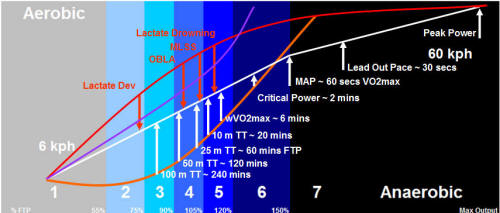FAQ ~ Climbing With A Power Meter
Attacking the foot of the climb
838 watts, 162 bpm, this isn't
going to end well!
Before we go any further ~ all of the information on this page is relevant, whether you have a power meter or not. If not, please read on!
For me, the best way to use a power meter when you first get one, is just go out and ride. Gather data; the more data you have, the more informed and better decisions you can make.
But first, you need to burn off that testosterone. Everyone does it, so don't worry about going out there and seeing how close to a 1000 watts you can get.
Sprint for every sign, smash yourself on every hill and go harder then you can, for less time than you thought, to see what the numbers are.
Once you've got that out of your system, we can begin...
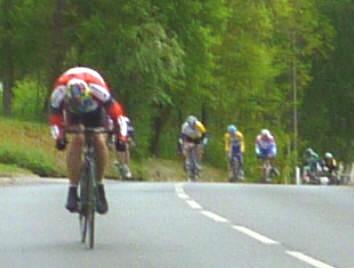
Ble D'Or sportive finishing climb
On the rivet, on the edge, nearly on the
podium...
Test Climb One...
Find yourself a half decent, steady gradiented climb of around three to five minutes.
Get a solid warm-up and when you're ready head to the base of
the climb, choosing your gear wisely.
Now, smash up the climb as hard as you possibly dare. This is a do or die, Strava KOM, ride it like you stole it, effort. You are aiming to be the fastest person ever to ride this hill.
Once you get your sight back, go for a nice steady cruise and calm down. Then go and find a few more hills to attack, or repeat the one you've done; four or five efforts should be enough for today.
Get yourself home, download your data and single out the climbs to get the lowdown.
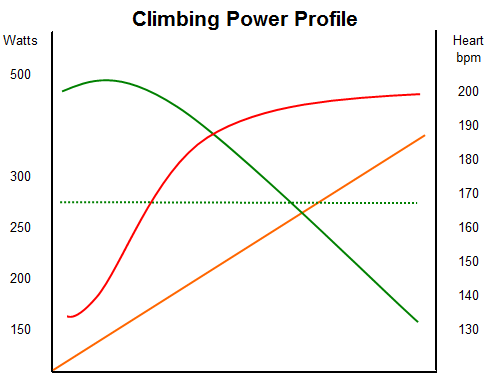
Your bog standard, ride it like you stole it effort
The Standard (Inexperienced) Climbing Model
Now I've seen literally hundreds of files like this; this is how
they all go. This is how most riders attack a climb whether
they have a power meter or not. That is, until they learn the
secret!
The orange line is the climb profile. The solid green line, the power output used to scale it. The dotted line, the power average for the whole climb. Red is heart rate.
To better explain the principles behind what is happening, all power numbers are conceptual. Remember, power numbers mean nothing unless you know the weight of the rider!
Most riders "attack" the start of the climb, with a hope of either opening a gap, getting a good "run up" or naively hoping they can hang on until they can get to the top.
It starts with a surge, (in this case) of up to 500 watts. As the slope begins to bite, and oxygen deficit begins to loom, power slowly drifts down, and down, and down, until they slowly crawl over the crest, at an exhausted and debilitating 175 watts.
Drained, scarlet in the face, lactated to the gunnels, and breathing through every orifice. It's not a good look.
We're not overly concerned with heart rate, but you can see it went from 130-ish, rapidly shot up to 190-ish and steadily climbed to its max from around a third of the way up.
Lets assume, this has been an exactly six minute climb (around VO2max) and it's been accomplished with an "average" power of 275 watts. Started at 500, dropped steadily to end at 175, stung like a good 'un.
Surely there has to be a better way?

Last climb of the Jean Cyril Robin Sportive
spot the riders that burnt their matches in the previous 150 kms
The Alternative (Pro?) Climbing Model
There are many ways to attack a climb, and you have to find out
which is best for you, your physiology, and your genetic make up.
But here's something for you to consider.
What we're going to show you here, is the best way for the vast majority of us to tackle a climb, any climb. Be it six, or sixty, minutes.
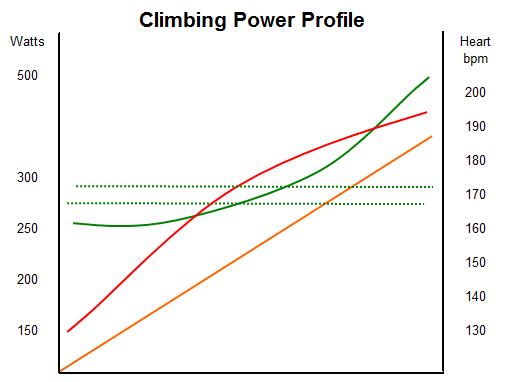
The textbook approach to scaling a climb?
As you hit the early slopes of the climb, it's vital that you stay somewhere between your FTP (your 60 minute power output) and the average of your first attempt, in this instance 275 watts.
If you hit the climb steady, you don't go in to oxygen debt, you don't elevate your heart rate and you don't flood the legs with lactate.
So hit the climb steady, within the parameters stated, and everything will (physiologically) remain within your control.
If you are on a group ride, what will mess with your head, is that more than likely, a lot of riders will begin to pass you; rapidly! Forgive them, for they know not what they do. You have a plan, stick to it.
You've ridden the climb before, so you know where the top is and how it pans out. Stick to the numbers.
A third of the way in to the climb, start to raise your revs slightly, maybe just one rpm. No shocks to the system; everything we do, we do slowly, steadily and smoothly. Your speed increase should be turbine like smooth and almost imperceptible to those around you.
Your heart rate is now gently increasing, along with your effort, but everything is still manageable and within parameters.
You are nowhere near oxygen debt, and lactate is within tolerances. Breathing is rhythmic, deep and controlled. All is good.
Stairway To Heaven
At the halfway point, the rate of increase of your heartbeat starts to flatten
out as it creeps towards its lower-upper ranges. It's at this
point that you start to pass those riders that screamed off at the bottom.
It's now time to increase power output again and take it above your average of the previous ride.
There are around three minutes left to the top of the climb. Now is the time to slowly, slowly build to your three minute average power output, rather than hold your six minute average.
No use holding a six minute average for what is now a three minute climb. Is it beginning to make any sort of sense yet?
For the last third, you can start to accelerate over the top of the climb and prepare to push on over the crest.
Remember, on your first attempt your heart rate was heading off the scale and your power was dropping like a stone. Things were spiraling out of your control.
Now, you are in control, you're passing all those that left you for dead at the bottom. And when you get to the top, you're still in a position to "push on", should the need arise.
Normally, heart rate peaks out around five beats lower than your first attempt. Cresting power is up (in this case 300 watts minimum), and your average power is now 290 watts, up from 275 watts.
More importantly, you've lopped twenty seconds off your previous time of six minutes and have suffered less physiological cost for the extra effort.
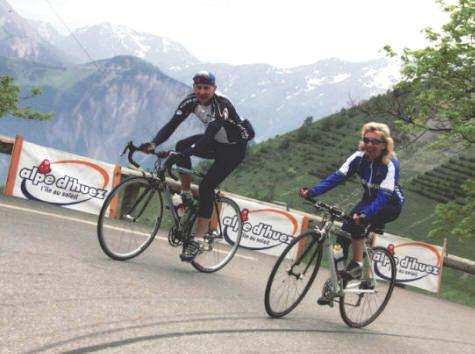
six minutes or sixty minutes, the approach is
the same
slow at the bottom, faster (with smiles) at the top
What next?
It doesn't matter how long, or short the climb, the principle is
always the same. Ride the climb, get a baseline average power for
ascending it.
The second time you ride it, stay under the baseline average for the first half of the climb, extending it out as you near the summit. You will invariably end up with a new average power for the climb.
The third time you ride it, stay below the new average power until you get to the first third of the climb, then slowly ramp up as before.
More than likely, you will again have another, higher average power for your ever shortening climb.
The fourth time you ride it, hit the bottom at the latest average wattage and again, slowly increase your output in manageable chunks.
Within a month or so, you will be climbing forty seconds quicker on a previously six minute climb. Within eight weeks, you could be hitting five minutes! All this will be achieved with an average power output that would have previously been unbelievable, or indeed, unachievable.
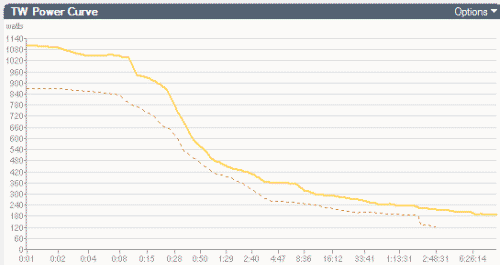
This change in approach will bring a profound change in climbing fitness, self-knowledge and physiological efficiency.
Within a very short space of time, your power curve will move from the dotted line, upwards and to the right, to the position of the solid line. All for less physiological cost. How good is that?
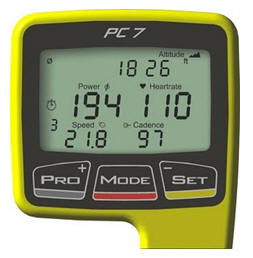 No
Power Meter?
No
Power Meter?
Riders have been riding climbs this way for a hundred years.
You don't need a power meter to change, or tell you, the way to ride your bike!
A power meter is just a tool you can use to help guide you. If you don't have one, use your heart, lungs and legs. They work just as well if you pay attention to them.
Get a feel for where your limits are and learn to understand and trust the signals your body sends you.
Eddy Merckx and Bernard Hinault never had power meters.
Trust your instincts, ride within yourself and progress on feel. A power meter just gives an objective number to the effort you are applying. Ride natural and you will subjectively feel these efforts for yourself.
Climbs You've Never Seen...?
So what happens if you're in a race, a sportive or just out on a
climb you've never seen before? Simple, just apply the same
principles but on a bigger scale.
If you're in the mountains, well FTP is your saviour. For the BIG climbs, there's no point riding at your VO2max to see how long you can hang on. We all know it's not going to be for very long.
But we do know that big climbs like the Marie Blancq, Hautacam, Alp D'Huez and the Galibier, Stelvio, etc, are all rider eating monsters that deserve our respect.
We also know that our FTP is our 60 minute power output. So why is it, that every time I ride Alp D'Huez, there are people "sprinting" the first three bends at VO2max level efforts! It's never going to end well.
If in the mountains, you ride at, or around, your sixty minute power output, although you may have to make allowances. You can read about altitude effects elsewhere.
If in a hilly area, like the Ardennes, Ardeche or Alsace regions, you ride just below your MLSS (Maximum Lactate Steady State) effort, which is your twenty minute power output.
Finally, if you are in a "lumpy area", Flanders, Brittany, Lombardy, etc, you stay around, but below, VO2max levels.
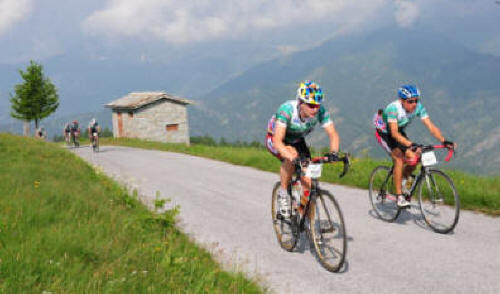
on top of the world ~ Fausto Coppi Sportive
with a knowledgeable local!
As with all these things, if in doubt, pick a local that looks like they know what they are doing, and be guided by them!
If there isn't one around, use our Physiological Continuum as a starter!
The Message
You can't just keep hitting climbs as hard as you can,
holding on for as long as you can, and expect
orders of magnitude improvements. If you want to change your
results, you have to change your approach.
Why not try it? Just pick a climb, give it a go and measure the results. Within two rides, you'll be convinced.
Power meter, or no power meter, it makes no difference. Leave your ego and testosterone at home. Grab a Garmin, get a Strava account, or just use the interval timer on your computer and go look for some climbs.
Have fun until next time...


